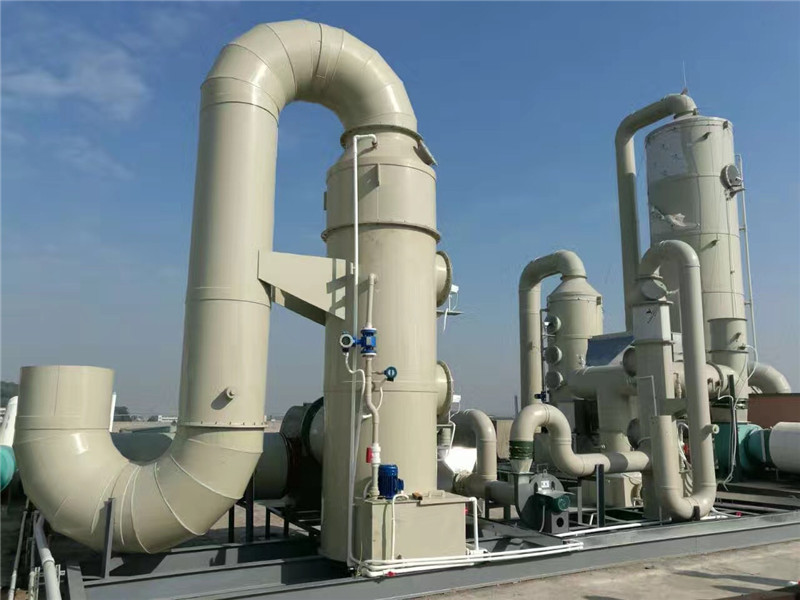- All
- Product Name
- Product Keyword
- Product Model
- Product Summary
- Product Description
- Multi Field Search
Views: 12 Author: Xicheng EP LTD Publish Time: 2023-06-17 Origin: Xicheng EP LTD
In the pursuit of environmental sustainability, the focus on reducing air pollution and mitigating its adverse effects has become paramount. An essential aspect of achieving cleaner air lies in the development and implementation of exhaust gas cleaning systems. These systems employ various methods and technologies to purify and reduce the harmful emissions released into the atmosphere. In this article, we will explore the three primary methods of purifying exhaust gas, delve into different types of exhaust scrubbers, and highlight the overarching purpose of gas purification.

Catalytic Conversion:
Catalytic conversion is a widely utilized method in exhaust gas cleaning systems, particularly in the automotive industry. It involves the use of a catalytic converter, a device containing specialized catalysts such as platinum, palladium, and rhodium. As exhaust gases pass through the catalytic converter, these catalysts facilitate chemical reactions that convert harmful pollutants into less harmful substances. For example, oxidation catalysts aid in the conversion of carbon monoxide (CO) and unburned hydrocarbons (HC) into carbon dioxide (CO2) and water (H2O). Three-way catalysts are employed to simultaneously reduce nitrogen oxides (NOx), CO, and HC emissions.
Filtration:
Filtration methods play a crucial role in capturing and removing solid particles, commonly known as particulate matter (PM), from exhaust gases. Diesel Particulate Filters (DPFs) are widely used in diesel engines. These filters employ porous materials to trap and accumulate PM emissions, such as soot. Periodic regeneration processes, including high-temperature combustion or catalytic oxidation, eliminate the accumulated PM, ensuring the continued efficiency of the filter. Moreover, other filter types such as wall-flow filters and ceramic filters are employed to reduce the emissions of fine particles in diverse applications.
Chemical Conversion:
Chemical conversion methods, such as Selective Catalytic Reduction (SCR), are employed to minimize nitrogen oxide (NOx) emissions. SCR systems utilize a catalyst, typically based on vanadium or other metals, in combination with a reducing agent like Diesel Exhaust Fluid (DEF) or AdBlue. The system injects the DEF into the exhaust stream, where the catalyst facilitates a chemical reaction that converts NOx into nitrogen (N2) and water vapor (H2O). This method significantly reduces the harmful effects of NOx emissions on air quality and human health.
Wet Scrubbers:
Wet scrubbers, also known as absorbers, are devices designed to remove pollutants from exhaust gas streams by employing a liquid solution or slurry. The exhaust gas passes through the scrubber, where it comes into contact with the liquid, promoting the absorption of pollutants. Wet scrubbers effectively remove various pollutants, including sulfur dioxide (SO2), acid gases, and particulate matter. Common types of wet scrubbers include venturi scrubbers, packed bed scrubbers, and spray tower scrubbers.
Dry Scrubbers:
Dry scrubbers, also referred to as adsorbers, are utilized to eliminate pollutants from exhaust gases without the use of a liquid solution. Instead, solid materials such as activated carbon or other adsorbents are employed to capture and adsorb pollutants. Dry scrubbers are commonly used for the removal of acid gases, such as sulfur dioxide (SO2), and can also target other pollutants like mercury (Hg) and volatile organic compounds (VOCs). Examples of dry scrubbers include dry sorbent injection systems and fabric filters.

Electrostatic Precipitators:
Electrostatic precipitators (ESP) are highly efficient devices used to remove particulate matter (PM) from exhaust gases through electrostatic attraction. As the exhaust gas passes through the precipitator, the particles become electrically charged. These charged particles are then attracted to and collected on oppositely charged plates or electrodes. ESPs are particularly effective in capturing fine particles, including PM2.5 and PM10, thereby significantly reducing their emissions.
The overarching purpose of gas purification is to reduce the emissions of harmful pollutants into the atmosphere, consequently mitigating their adverse effects on human health and the environment. By purifying exhaust gases, gas purification systems aim to minimize the release of toxic substances, such as carbon monoxide (CO), nitrogen oxides (NOx), particulate matter (PM), sulfur dioxide (SO2), and volatile organic compounds (VOCs). This helps in improving air quality, reducing respiratory ailments, and mitigating the impact of pollution on climate change.
Moreover, gas purification systems are crucial for compliance with environmental regulations and standards set by governing bodies. They enable industries and vehicles to meet emission requirements, fostering sustainable practices and contributing to a cleaner and healthier future.
Conclusion:
Exhaust gas purification systems, incorporating various methods of purification and different types of scrubbers, are integral to reducing air pollution and ensuring a sustainable environment. Through catalytic conversion, filtration, and chemical conversion, harmful emissions are transformed into less harmful substances. Wet scrubbers, dry scrubbers, and electrostatic precipitators further aid in capturing and removing pollutants from exhaust gases. The purpose of gas purification is to improve air quality, safeguard human health, comply with regulations, and strive towards a greener future. By embracing these advancements, we can create a cleaner and healthier planet for generations to come.
| | N0.34 Zhenxing Road (Shengtaian Heavy Industrial Park B), Loucun, Guangming New Dist, Shenzhen, Guangdong, China |
| | +86 18028775826 |
| | Leyte@china-xicheng.com |